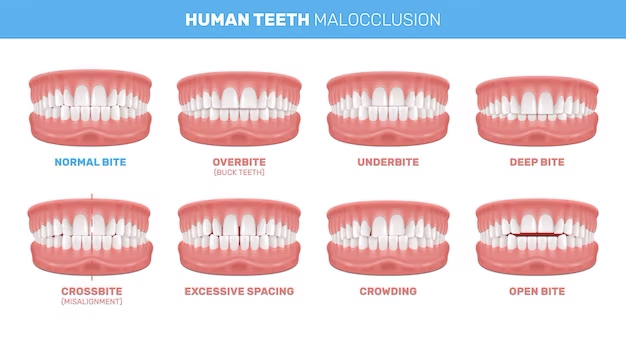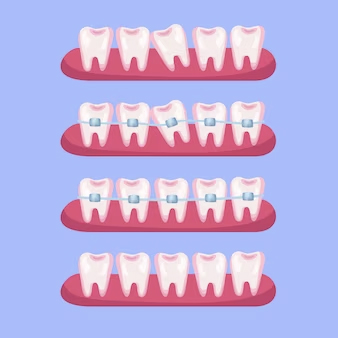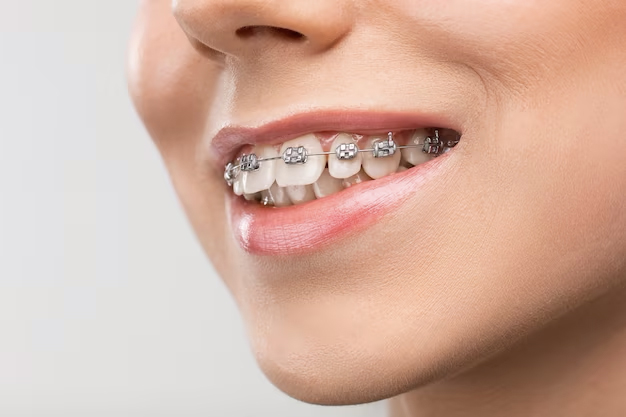Orthodontics is a branch of dentistry that focuses on the diagnosis, prevention, and treatment of dental and facial irregularities. The field of orthodontics primarily deals with correcting misaligned teeth and jaws, improving the overall function and aesthetics of the mouth.
Discover the transformation power of orthodontic treatment.

When you need to make Orthodontics?
Almost everyone can gain some benefit from orthodontics. But some people need treatment more than others. Many people seek orthodontic treatment because they want to improve the appearance of their smile. But in addition to cosmetic benefits, orthodontics offers improved chewing function and better oral health.
Orthodontic treatment involves the use of various appliances, such as braces, aligners, and other devices, to gradually move teeth into their proper positions. These appliances apply gentle pressure to the teeth and jaws, which helps to reposition them over time. The specific treatment plan depends on the individual’s dental needs and goals.
The benefits of orthodontic treatment
Improved Confidence:
Crooked or misaligned teeth can have a negative impact on one’s self-esteem and confidence. Orthodontic treatment can help align your teeth, giving you a beautiful and confident smile. Feeling good about your smile can positively affect how you interact with others and boost your overall self-image.
Enhanced Aesthetics:
Orthodontics can significantly improve the appearance of your teeth and face. By aligning your teeth and correcting any irregularities, orthodontic treatment can enhance your facial symmetry and create a more harmonious smile. This aesthetic enhancement can have a positive impact on your overall facial attractiveness.
Better Oral Health:
Straightening your teeth through orthodontic treatment not only enhances the appearance but also contributes to better oral health. Misaligned teeth can make it challenging to clean them properly, leading to a higher risk of tooth decay, gum disease, and other dental problems. Orthodontic treatment aligns the teeth, making them easier to clean and maintain, thus promoting good oral health.
Improved Functionality:
Orthodontic treatment not only focuses on the appearance of your teeth but also addresses bite issues and jaw misalignments. By correcting these problems, orthodontics can improve your bite functionality, making it easier to chew food properly, speak clearly, and alleviate any discomfort or pain caused by jaw misalignment.
By discovering the transformational power of orthodontic treatment, you can gain a deeper understanding of the benefits it offers and how it can positively impact your life. It’s important to consult with an orthodontist who can assess your dental condition and provide professional guidance on the most suitable treatment options for you. Translate this into Arabic.
common orthodontic issues that can be addressed through treatment.
Malocclusions: These refer to misalignments of the teeth and/or jaws, including overbites, underbites, crossbites, and open bites.
Crowding: When there is inadequate space in the jaw to accommodate all the teeth, crowding occurs. This can lead to overlapping or twisted teeth.
Spacing: Gaps or spaces between teeth can occur due to missing teeth, small teeth, or excessive jaw space. Orthodontic treatment can help close these spaces.
Overjet: This refers to protrusion of the upper front teeth beyond the lower teeth, often known as “buck teeth.”
Orthodontic treatment: typically begins with a comprehensive evaluation, including dental X-rays, photographs, and impressions of the teeth. Based on the diagnosis, the orthodontist creates an individualized treatment plan.
Traditional metal braces :are commonly used in orthodontics. They consist of metal brackets bonded to the teeth and connected by wires. Over time, the wires are adjusted to gradually move the teeth into the desired positions.
Orthodontic treatment duration: varies depending on the complexity of the case, but it generally lasts from several months to a few years. Regular visits to the orthodontist are necessary for adjustments and monitoring progress.
Orthodontics not only improves the appearance: of the smile but also helps with proper tooth alignment, bite function, and long-term oral health. It is essential to maintain good oral hygiene during treatment and follow the orthodontist’s instructions for optimal results.
Types of orthodontic
Metal orthodontics:
Traditional metal braces are the most well-known forms of fixed orthodontics, consisting of brackets or brackets made of high-quality stainless steel that are attached to each tooth with a special type of adhesive that does not affect the teeth.
These blocks are linked together with a metal wire and rubber bits, and the doctor tightens it in a precise way to push on the teeth and correct their position.
Metal braces are the most popular and least expensive, as they are acceptable for both toddlers and adults and treat tough situations well.
Self-binding metal orthodontics:
Self-ligating braces, often known as Damon braces, are a kind of fixed orthodontics. It resembles the shape of fixed metal braces, except that the brackets in self-tie braces are uniquely designed so that the metal wire is fixed in them without the need for rubber pieces as in metal braces, which reduces friction and pressure and makes it less painful, as well as making cleaning the teeth easier.
Internal orthodontics:
Lingual Braces, also known as back orthodontics or lingual braces, are a form of fixed orthodontic appliance that is also considered invisible orthodontics.
Internal orthodontics consists of metal pieces connected by a metal wire, however they are fastened to the teeth from the inside so that they face the tongue and are not visible from the front.
Internal fixed orthodontics is typically used for people who have voids, matches, or severe sprains in their teeth, and it is chosen by patients since it is concealed and does not create shame in its shape.
The period of usage of these braces is the longest compared to other types, and it may be difficult to clean the mouth and clean the braces themselves from the inside, and one of its downsides is that it can lead to tongue wounds, and it requires great competence from the doctor to install it.
Ceramic orthodontics:
Ceramic braces are a sort of fixed invisible orthodontics. Their braces are quite similar to metal braces in size and structure, but they are transparent made of porcelain or ceramic so that they blend with the natural color of the teeth, and they are connected to each other via a plastic wire.
This method of orthodontics moves teeth quicker than transparent braces and achieves the same results as traditional orthodontics in terms of tooth movement in the targeted positions.
Because of the hue of porcelain, which makes it unobtrusive, it is frequently used for orthodontic treatment.
One of the more expensive varieties of dental braces is ceramic orthodontics, which requires special maintenance from the wearer in terms of cleaning and following up with the dentist to confirm the installation’s safety. Because ceramic orthodontics are prone to breaking easily, it is advised to use extreme caution when eating food or ice cream.
Clear Aligners:
are made of transparent plastic molds of acrylic, and these molds are made to fit the teeth after a doctor’s examination and radiography to determine the size of the jaw and teeth.
Clear orthodontics can be easily installed and removed when eating or brushing teeth. It is one of the types of invisible orthodontics, so many people prefer it for its aesthetic shape compared to other types, but it is expensive; it’s requires attention while cleaning, eating, and drinking, and it takes at least 22 hours every day to achieve the desired effects.
Clear orthodontics is often not utilized on youngsters and is only used to treat minor to moderate dental issues in adults and teenagers.
If you are considering orthodontic treatment, it is best to consult an orthodontist who can assess your specific needs and provide appropriate recommendations.


